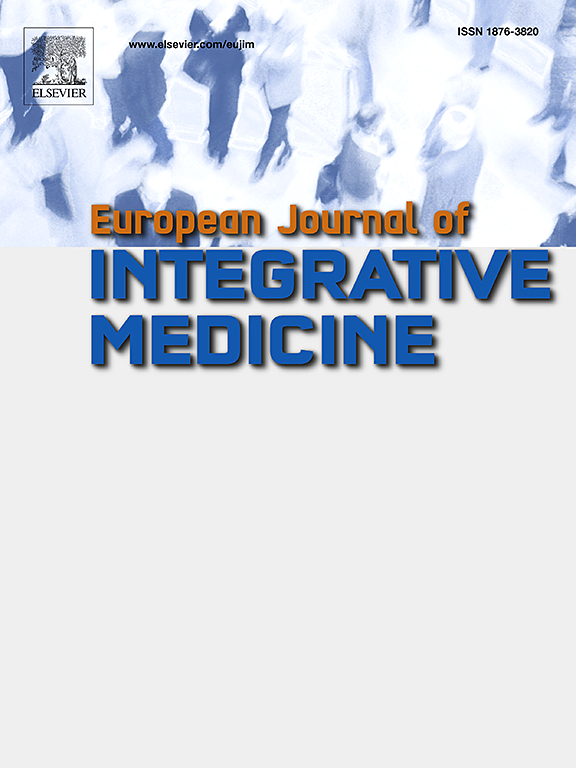Impact of pediatric Tui Na over three months on children’s growth: A systematic review and meta-analysis of randomized controlled trials
IF 1.7
4区 医学
Q3 INTEGRATIVE & COMPLEMENTARY MEDICINE
引用次数: 0
Abstract
Introduction
This review aims to evaluate the effectiveness and safety of pediatric Tui Na on children’s growth.
Methods
The protocol of this review was registered in INPLASY (10.37766/inplasy2024.2.0116). We searched seven databases and two ongoing trial registers up to June 8, 2024, for randomized controlled trials (RCTs) of pediatric Tui Na, to assess the impact of Tui Na lasting over 3 months on children’s growth. Risk of bias was assessed with the RoB1 tool. Results were presented and synthesized via RevMan 5.4.
Results
A total of 46 RCTs involving 11,284 children were included. We found that Tui Na increased height compared to routine health care alone (29 trials, mean 3.68 cm, 95 % CI (confidence interval) [2.92, 4.43], low-certainty evidence) and to touch (2 trials, mean 1.72 cm, 95 % CI [1.22, 2.22], low-certainty evidence). Adding Tui Na to touch resulted in a height increase of 1.99 cm (5 trials, mean 95 % CI [1.04, 2.95], low-certainty evidence). Subgroups of normal children (Tui Na for 3-4 months, 5-6 months, 12 months) and preterm children (Tui Na for 3-4 months, 12 months) both showed significant benefits. Tui Na was also beneficial for the growth of height, weight, head circumference, chest circumference, waist circumference and BMI, as well as parental satisfaction compared to routine health care. Compared to touch, Tui Na was beneficial for growth of height, weight and head circumference. Tui Na also showed additional benefits in growth of height, weight and head circumference added to touch. RevMan 5.4 was used for the meta-analyses and funnel plots.
Conclusion
This evaluation indicates that Tui Na over 3 months can promote children’s growth and appears to be safe, with high parental satisfaction. However, large-sample and high-quality RCTs and real-world observations with long-term follow-up are needed to confirm these findings.
小儿推脑3个月以上对儿童生长发育的影响:随机对照试验的系统回顾和荟萃分析
本综述旨在评价小儿推那对儿童生长发育的有效性和安全性。方法本综述方案在INPLASY注册(10.37766/inplasy2024.2.0116)。截至2024年6月8日,我们检索了7个数据库和2个正在进行的试验注册库,以评估持续3个月以上的推那对儿童生长的影响。使用RoB1工具评估偏倚风险。用revman5.4软件对结果进行了分析和合成。结果共纳入46项随机对照试验,涉及11284名儿童。我们发现,与单纯的常规保健相比,推纳组的身高增加(29项试验,平均3.68 cm, 95% CI(可信区间)[2.92,4.43],低确定性证据),与触摸组相比(2项试验,平均1.72 cm, 95% CI[1.22, 2.22],低确定性证据)。将推那添加到触摸中导致身高增加1.99 cm(5项试验,平均95% CI[1.04, 2.95],低确定性证据)。正常儿童(3-4个月,5-6个月,12个月)和早产儿(3-4个月,12个月)的亚组均显示出显着的益处。与常规保健相比,推纳对身高、体重、头围、胸围、腰围、BMI、父母满意度的增长也有好处。与触摸相比,推纳有利于身高、体重和头围的增长。推娜在身高、体重和头围的增长方面也显示出额外的好处。meta分析和漏斗图采用RevMan 5.4。结论3个月以上推那可促进儿童生长发育,安全性好,家长满意度高。然而,需要大样本、高质量的随机对照试验和长期随访的真实世界观察来证实这些发现。
本文章由计算机程序翻译,如有差异,请以英文原文为准。
求助全文
约1分钟内获得全文
求助全文
来源期刊

European Journal of Integrative Medicine
INTEGRATIVE & COMPLEMENTARY MEDICINE-
CiteScore
4.70
自引率
4.00%
发文量
102
审稿时长
33 days
期刊介绍:
The European Journal of Integrative Medicine (EuJIM) considers manuscripts from a wide range of complementary and integrative health care disciplines, with a particular focus on whole systems approaches, public health, self management and traditional medical systems. The journal strives to connect conventional medicine and evidence based complementary medicine. We encourage submissions reporting research with relevance for integrative clinical practice and interprofessional education.
EuJIM aims to be of interest to both conventional and integrative audiences, including healthcare practitioners, researchers, health care organisations, educationalists, and all those who seek objective and critical information on integrative medicine. To achieve this aim EuJIM provides an innovative international and interdisciplinary platform linking researchers and clinicians.
The journal focuses primarily on original research articles including systematic reviews, randomized controlled trials, other clinical studies, qualitative, observational and epidemiological studies. In addition we welcome short reviews, opinion articles and contributions relating to health services and policy, health economics and psychology.
 求助内容:
求助内容: 应助结果提醒方式:
应助结果提醒方式:


